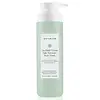What's inside
What's inside
 Key Ingredients
Key Ingredients

 Benefits
Benefits

 Concerns
Concerns

 Ingredients Side-by-side
Ingredients Side-by-side

Water
Skin ConditioningGlycerin
HumectantCocamidopropyl Betaine
CleansingKaolin
AbrasiveDecyl Glucoside
CleansingAcrylates Copolymer
Brassica Campestris/Aleurites Fordi Oil Copolymer
Skin ConditioningIllite
AbrasiveMontmorillonite
AbsorbentSqualane
EmollientAloe Barbadensis Leaf Extract
EmollientBioflavonoids
Skin ConditioningBrassica Oleracea Italica Extract
AstringentTocopherol
AntioxidantSodium Lauroyl Sarcosinate
CleansingXanthan Gum
EmulsifyingEthylhexylglycerin
Skin ConditioningTetrasodium Glutamate Diacetate
Magnesium PCA
HumectantPropanediol
SolventSodium Benzoate
MaskingSodium Chloride
MaskingSodium Hydroxide
BufferingPhenoxyethanol
PreservativeWater, Glycerin, Cocamidopropyl Betaine, Kaolin, Decyl Glucoside, Acrylates Copolymer, Brassica Campestris/Aleurites Fordi Oil Copolymer, Illite, Montmorillonite, Squalane, Aloe Barbadensis Leaf Extract, Bioflavonoids, Brassica Oleracea Italica Extract, Tocopherol, Sodium Lauroyl Sarcosinate, Xanthan Gum, Ethylhexylglycerin, Tetrasodium Glutamate Diacetate, Magnesium PCA, Propanediol, Sodium Benzoate, Sodium Chloride, Sodium Hydroxide, Phenoxyethanol
Water
Skin ConditioningSodium Cocoyl Methyl Isethionate
Sodium Cocoyl Isethionate
CleansingCocamidopropyl Hydroxysultaine
CleansingCocamidopropyl Betaine
CleansingGlycerin
HumectantCoco-Glucoside
CleansingPolyquaternium-73
Anthemis Nobilis Flower Oil
MaskingNiacinamide
SmoothingPanthenol
Skin ConditioningCamellia Sinensis Leaf Extract
AntimicrobialAscorbyl Glucoside
AntioxidantHippophae Rhamnoides Fruit/Seed Oil
AntimicrobialPyrus Malus Fruit Extract
Skin ConditioningPolyquaternium-10
Magnesium PCA
HumectantManganese PCA
HumectantZinc PCA
HumectantSodium PCA
HumectantSodium Lactate
BufferingPCA
HumectantSerine
MaskingAlanine
MaskingGlycine
BufferingGlutamic Acid
HumectantLysine Hcl
Skin ConditioningThreonine
Arginine
MaskingProline
Skin ConditioningLauryl Glucoside
CleansingTocopheryl Acetate
AntioxidantBetaine
HumectantCaprylyl Glycol
EmollientDidecyldimonium Chloride
EmulsifyingMethylpropanediol
SolventPolyquaternium-80
CleansingChamomilla Recutita Flower Extract
MaskingCitrus Aurantium Bergamia Fruit Extract
Skin ConditioningCitrus Limon Peel Extract
EmollientLavandula Angustifolia Flower/Leaf/Stem Extract
MaskingRosmarinus Officinalis Leaf Extract
AntimicrobialRubus Idaeus Fruit Extract
AstringentSalvia Officinalis Leaf Extract
CleansingVanilla Planifolia Fruit Extract
Skin ConditioningDecyl Glucoside
CleansingTetrasodium Glutamate Diacetate
Citric Acid
BufferingWater, Sodium Cocoyl Methyl Isethionate, Sodium Cocoyl Isethionate, Cocamidopropyl Hydroxysultaine, Cocamidopropyl Betaine, Glycerin, Coco-Glucoside, Polyquaternium-73, Anthemis Nobilis Flower Oil, Niacinamide, Panthenol, Camellia Sinensis Leaf Extract, Ascorbyl Glucoside, Hippophae Rhamnoides Fruit/Seed Oil, Pyrus Malus Fruit Extract, Polyquaternium-10, Magnesium PCA, Manganese PCA, Zinc PCA, Sodium PCA, Sodium Lactate, PCA, Serine, Alanine, Glycine, Glutamic Acid, Lysine Hcl, Threonine, Arginine, Proline, Lauryl Glucoside, Tocopheryl Acetate, Betaine, Caprylyl Glycol, Didecyldimonium Chloride, Methylpropanediol, Polyquaternium-80, Chamomilla Recutita Flower Extract, Citrus Aurantium Bergamia Fruit Extract, Citrus Limon Peel Extract, Lavandula Angustifolia Flower/Leaf/Stem Extract, Rosmarinus Officinalis Leaf Extract, Rubus Idaeus Fruit Extract, Salvia Officinalis Leaf Extract, Vanilla Planifolia Fruit Extract, Decyl Glucoside, Tetrasodium Glutamate Diacetate, Citric Acid
 Reviews
Reviews

Ingredients Explained
These ingredients are found in both products.
Ingredients higher up in an ingredient list are typically present in a larger amount.
Cocamidopropyl Betaine is a fatty acid created by mixing similar compounds in coconut oil and dimethylaminopropylamine, a compound with two amino groups.
This ingredient is a surfactant and cleanser. It helps gather the dirt, pollutants, and other impurities in your skin to be washed away. It also helps thicken a product and make the texture more creamy.
Being created from coconut oil means Cocamidopropyl Betaine is hydrating for the skin.
While Cocamidopropyl Betaine was believed to be an allergen, a study from 2012 disproved this. It found two compounds in unpure Cocamidopropyl Betaine to be the irritants: aminoamide and 3-dimethylaminopropylamine. High-grade and pure Cocamidopropyl Betaine did not induce allergic reactions during this study.
Learn more about Cocamidopropyl BetaineDecyl Glucoside is a glucose-based surfactant and emulsion stabilizer. It is created by reacting glucose with the fatty acids from plants.
Surfactants help clean the skin by trapping oil, sebum, and dirt to be washed away. As an emulsion stabilizer, it stabilizes the ingredients in a product by preventing them from separating.
This ingredient is biodegradable and non-toxic. This ingredient is commonly found in baby shampoos.
Decyl Glucoside is sometimes used to stabilize the UV filter Tinosorb.
Learn more about Decyl GlucosideGlycerin is already naturally found in your skin. It helps moisturize and protect your skin.
A study from 2016 found glycerin to be more effective as a humectant than AHAs and hyaluronic acid.
As a humectant, it helps the skin stay hydrated by pulling moisture to your skin. The low molecular weight of glycerin allows it to pull moisture into the deeper layers of your skin.
Hydrated skin improves your skin barrier; Your skin barrier helps protect against irritants and bacteria.
Glycerin has also been found to have antimicrobial and antiviral properties. Due to these properties, glycerin is often used in wound and burn treatments.
In cosmetics, glycerin is usually derived from plants such as soybean or palm. However, it can also be sourced from animals, such as tallow or animal fat.
This ingredient is organic, colorless, odorless, and non-toxic.
Glycerin is the name for this ingredient in American English. British English uses Glycerol/Glycerine.
Learn more about GlycerinThis ingredient is the magnesium salt of PCA (Pyrrolidone Carboxylic Acid). It is a great skin hydrator for the top layers of skin.
PCA is a natural humectant, meaning it draws water from the air to your outer layer of skin.
One study found magnesium ions improved skin hydration in the outer layer of skin, or the stratum corneum. However, it did not improve TEWL, or the transepidermal water loss. The TEWL is an indicator of how healthy your skin barrier function is. This study primarily looked at healthy skin with intact skin barrier.
Learn more about Magnesium PCATetrasodium Glutamate Diacetate is a chelating agent. Chelating agents help prevent metal ions from binding to other ingredients. This helps prevent unwanted effects and reactions from a product. These metal ions may come from water and are found in miniscule amounts.
Tetrasodium Glutamate Diacetate can also help other preservatives be more effective.
Water. It's the most common cosmetic ingredient of all. You'll usually see it at the top of ingredient lists, meaning that it makes up the largest part of the product.
So why is it so popular? Water most often acts as a solvent - this means that it helps dissolve other ingredients into the formulation.
You'll also recognize water as that liquid we all need to stay alive. If you see this, drink a glass of water. Stay hydrated!
Learn more about Water